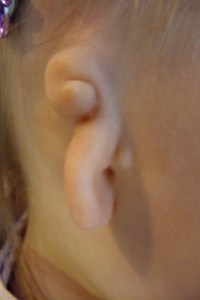For children born with microtia and atresia, getting them access to sound for their affected ear or ears is crucial to provide them with all opportunities to hear the world around them. Learn more about the Cochlear™ Baha® Sound Processor as a solution to treat their hearing loss.
What is microtia and/or atresia?

Microtia is a congenital deformity that affects the outer ear, where the ear does not fully develop during pregnancy. Microtia derives its name from the Latin term for little ear. A microtia ear is often smaller in size, can have a peanut shaped appearance, only have a small nub or lobe present or can be completely absent at birth1. Microtia is often accompanied by atresia.
Atresia is the absence or closure of the ear canal. The malformation of the middle ear bones may be affected, including the narrowing of the ear canal1.
How could a Baha System help your child?
Hearing loss in your child’s affected ear or ears could be helped with a bone conduction hearing device, like a Baha Sound Processor. A Baha Sound Processor uses your child’s natural ability to conduct sound through bone vibrations. With bone conduction, sound bypasses the damaged outer or middle ear and sends clearer, more crisp sound directly to their inner ear2.
Unlike a hearing aid, which tries to push sound through the damaged part of your child’s ear, the Baha System bypasses their outer ear and sends sound straight to their functioning inner ear (cochlea).
If your child is too young* for an implant, there are other non-surgical solutions such as the Baha Softband or the Baha SoundArc that can assist your child in their first steps to hearing.
Importance of early intervention for hearing loss
 Providing your child access to sound when hearing loss is first detected is important. The foundation of social skills and fundamental language building blocks are important to build as early as possible to ensure success in school and society later in life3.
Providing your child access to sound when hearing loss is first detected is important. The foundation of social skills and fundamental language building blocks are important to build as early as possible to ensure success in school and society later in life3.
Hearing loss affects all ages, and loss of hearing can have negative impacts on children. For children, a limited ability to discern sounds can affect a child’s intellectual and emotional development4. Treating your child’s hearing loss is important for their health and well-being.
How the Baha System helped Bella P.
Bella P. was born with microtia and atresia in her right ear. Her parents were concerned for her not being able to hear out of one of her ears and started seeing signs of her hearing loss affecting her in school, namely in reading and comprehension. After reconstructive surgery for her ear, they made the choice to go with the Baha 5 System to give her every opportunity to learn and grow. Watch her story below:
Was your child born with microtia and/or atresia? Are you eager to find a solution to get them access to sound? Read more about the Baha System and give them the opportunity to better hear the world around them.
* In the United States and Canada, the Baha Implant is indicated for children ages 5 and older.
-
https://earcommunity.org/microtiaatresia/
-
Gustafsson J. BCDrive performance vs. conventional bone conduction transducer. Cochlear Bone Anchored Solutions AB, 629908, 2015.
-
Tharpe AM, Gustafson S. Management of Children with Mild, Moderate, and Moderately Severe Sensorineural Hearing Loss. Otolaryngol Clin North Am 2015 December: 983-994.
-
Bidadi S, Nejadkazem M, Naderpour M. The relationship between chronic otitis media-induced hearing loss and the acquisition of social skills. Archives of Otolaryngology – Head & Neck Surgery. 2008 Nov;139(5):665-70.